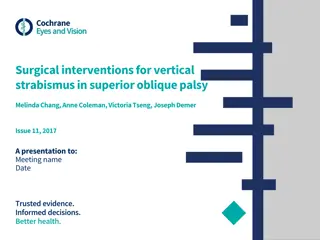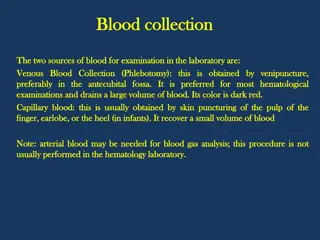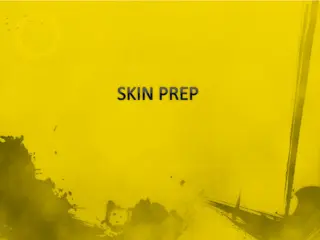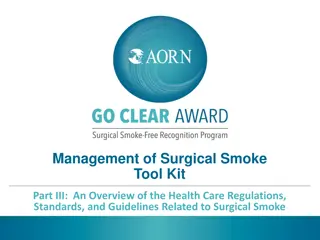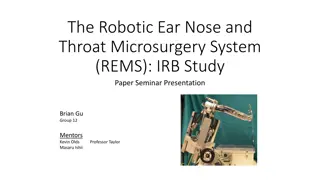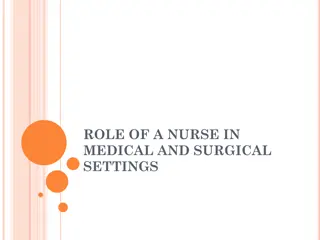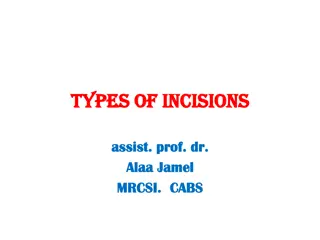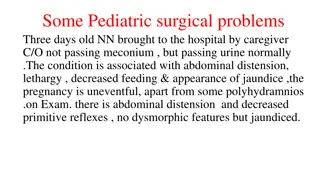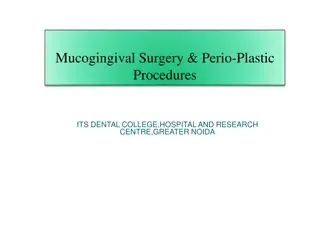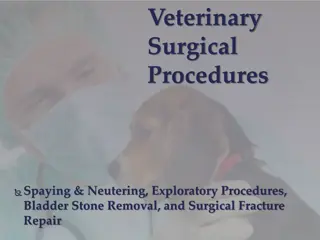Understanding Surgical Needles and Their Uses
Surgical needles come in various shapes and sizes, each designed for specific purposes based on tissue type, wound topography, and needle characteristics. The sharpest needles are made of stainless steel and have tapered points with smooth cutting edges. Eyed needles require threading, creating a larger hole in the tissue compared to swaged needles. The choice of needle shape depends on factors like tissue depth and wound size, influencing their application in medical procedures.
Download Presentation

Please find below an Image/Link to download the presentation.
The content on the website is provided AS IS for your information and personal use only. It may not be sold, licensed, or shared on other websites without obtaining consent from the author. Download presentation by click this link. If you encounter any issues during the download, it is possible that the publisher has removed the file from their server.
E N D
Presentation Transcript
Surgical Needles . .
Surgical Needles A variety of needle shapes and sizes are available; Selection of a needle depends on 1. The type of tissue to be sutured (e.g., penetrability, density, elasticity, and thickness), 2. The topography of the wound (e.g., deep or narrow) 3. The characteristics of the needle (i.e., type of eye, length, and diameter).
The sharpest needles have a long, thin, tapered point with smooth cutting edges. . Most surgical needles are made from stainless steel wire because it is strong, corrosion free, and does not harbor bacteria. The three basic components of a needle are the attachment end (i.e., swaged or eyed end), the body, and the point
Eyed needles must be threaded, and because a double strand of suture is pulled through the tissue, a larger hole is created than when swaged suture material is used. Eyed needles may be 1. closed (i.e., round, oblong, or square) or 2. French (i.e., with a slit from the inside of the eye to the end of the needle for ease of threading)
The use of eyed needles in veterinary practice has decreased substantially in recent years. With swaged sutures, the needle and suture form a continuous unit, which minimizes tissue trauma and increases ease of use.
The needle body comes in a variety of shapes the tissue type and depth and the size of the wound determine the appropriate needle shape. 1. Straight (Keith) needles generally are used in accessible places where the needle can be manipulated directly with the fingers (e.g., placement of purse-string sutures in the anus). 2. Curved needles are manipulated with needle holders. The depth and diameter of a wound are important when selecting the most appropriate curved needle.
One-fourth ( 1/4) circle needles are primarily used in ophthalmic procedures. Three-eighths ( 3/8) and one-half ( 1/2 ) circle needles are the most commonly used surgical needles in veterinary medicine. Three-eighths circle needles are more easily manipulated than one-half circle needles because they require less pronation and supination of the wrist. A one-half circle or five-eighths ( 5/8 ) circle needle, despite requiring more pronation and supination of the wrist, is easier to use in confined locations.
The needle point (i.e., cutting, taper, reverse cutting, or side cutting) affects the sharpness of a needle and the type of tissue in which the needle can be used.
Cutting needles generally have two or three opposing cutting edges and are designed for use in tissues that are difficult to penetrate, such as skin. With conventional cutting needles, the third cutting edge is on the inside (i.e., concave) curvature of the needle.
Reverse cutting needles have a third cutting edge on the outer (i.e., convex) curvature of the needle; this makes them stronger than similarly sized conventional cutting needles and reduces the amount of tissue cut out.
Side cutting needles (i.e., spatula needles) are flat on the top and bottom and are generally used for ophthalmic procedures.
Taper needles (i.e., round needles) have a sharp tip that pierces and spreads tissues without cutting them. They generally are used in easily penetrated tissues, such as the intestine, subcutaneous tissue, or fascia.
Taper-cut needles, which are a combination of a reverse cutting edge tip and a taper point body, generally are used for suturing dense, tough fibrous tissue, such as a tendon, and for some cardiovascular procedures, such as vascular grafts.
Bluntpoint needles have a rounded, blunt point that can dissect through friable tissue without cutting. They occasionally are used for suturing soft, parenchymal organs, such as the liver or kidney.






